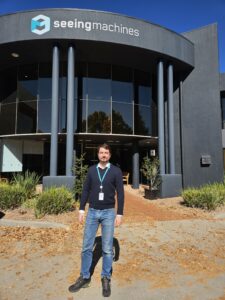Industry Collaboration: Metalens for Driver Monitoring
13 Jun, 2024
TMOS researchers collaborated closely with industry partner Seeing Machines to develop a metalens designed to be integrated into the company’s driver monitoring systems. Seeing Machines is a global leader in the computer vision systems and is working to minimise road deaths using advanced human data-driven technology to counteract driver distraction and drowsiness.
Seeing Machines has been a collaborator since the Centre’s inception, having quickly recognised the benefits flat optics would have to their driver monitoring system. TMOS Centre Director Dragomir Neshev says, “As demands for new automotive technology increase, the space in a car dashboard becomes more valuable. The natural next step for an optics-heavy company like Seeing Machines is to look at the miniaturisation of their work using flat optics. As a bonus, metasurfaces can also provide additional functionality that traditional optics doesn’t.”
 TMOS research fellow Andrei Komar has been a key driver of the collaboration since the beginning of this new project.
TMOS research fellow Andrei Komar has been a key driver of the collaboration since the beginning of this new project.
Komar says, “Seeing Machines collaborators taught us about automotive standards and processes of industrial certification, the kind of knowledge we lack in academia. This makes our device acceptable for the real-life applications. Seeing Machines also provided us with the requirements for new feature development so that it would be commercially successful. This directed our research in ways that lead to the new scientific knowledge and a successful industrial product.”
Komar met weekly with the Seeing Machines team to discuss the latest results and map a path forward. This helped them to keep on track of research novelty and industrial potential.
“The brought knowledge about the automotive industry and we brought the research components, like the scientific idea of how to build a new meta-optical component, theoretical and simulation implementation of the idea, fabrication, and experimental characterisation of every iteration.”
The collaboration also included TMOS team members from RMIT and the ANFF. The designed metalens had a large surface area and precise nano-structures. Those two factors required a specialised skillset and advanced machines in order to produce samples. RMIT research fellow Litty Thekkekra possessed the necessary knowledge of large area meta-optical nanofabrication and she worked with the Melbourne ANFF facility to fabricate the intermediate and final samples using their using their state-of-the-art electron beam lithography (EBL) fabrication facility.
The collaborative relationship between Komar and Seeing Machines was so successful that he recently accepted a position with the company to investigate a meta-optical approach for a new element, which will add the features to the element that are impossible when using conventional optics.
“This investigation will likely lead to new collaborative opportunities between Seeing Machines, TMOS and the ANFF,” says Komar.
Neshev says, “Watching Andrei move from academia to industry to has been very rewarding. The Centre’s purpose extends beyond research. We want to facilitate the quick adoption of meta-optics globally by developing our team to be knowledgeable, critical thinkers with skill sets that are valuable in an industry setting. Andrei’s move to Seeing Machines is the perfect example of this.”